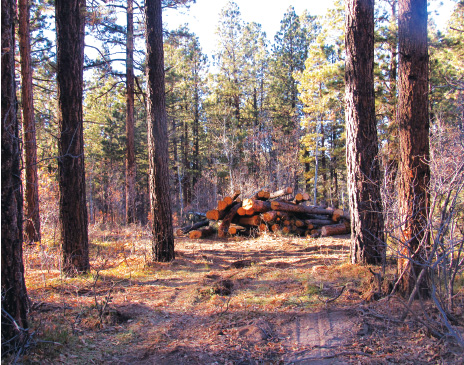
A social-distancing and re-purposing project for timber on Haycamp Mesa in Montezuma County.
Trees are like people in a lot of ways, they may even look like some people. You have seen some, tall and straight like a pine tree, or short and squatty like a juniper or even tall and straight but spreading in the lower “hips” like a spruce tree, or even tall and skinny, like an aspen. Some trees bend with however the wind blows, while others stand firm and fast even in a gale.
There are other more closely related ways common to man and trees. For example, both have their beginning from a “seed” planted in just the right environment with nourishment to grow. Once sprouted, both need food, water, sunlight and room to grow. When both are small, not much space is needed, but as more “sprouts” come along things can get pretty competitive. If there is not enough food, water, and space for all, then an unhealthy condition is created for all. Just like people, the bigger trees overshadow the smaller ones and suck up all the water, nutrients and sunlight, leaving the small ones weak and subject to viruses, bacteria, and other bugs.
Here is where we part ways. When your house gets too crowded with now young adults, you can boot the kids out to go their own way with their dreams and jobs. Trees in the forest just let the little ones starve. So all those unhealthy trees that are packed in too close to each other, one of them gets sick with a virus, or bacteria, bug or parasite of some kind.
What do you think happens? You guessed it! The “sickness” gets passed around to all those that are too close, wiping their branches on each other.
Here is where man can come to the rescue with a good medical plan. Man can help with implementing a “social distancing” for a new tree employment opportunity. Using scientific spacing guidelines for the social distancing, many trees can be given new purposes and careers in construction, home heating, essential oils, furniture, medicine, music, sports, cosmetics, barbecuing and even sanitation (TP). And the list goes on.
The trees of the forest are subject to diseases and hardships beyond their control, just like man. The trees are continually subject to numerous viruses, bacteria, insects and parasites, in addition to changing weather conditions of drought, floods, and windstorms. The overcrowding of trees stresses them out and weakens them to where the insects and other diseases easily overcome them. Just like man, the key to their survival is to be healthy to overcome the attacks. The best way is to be given space to grow with adequate sunlight, nutrients, and water with minimal competition from others. Locking the forest up in an unhealthy crowded condition will not prevent the attack of diseases, but rather exacerbate it, making it worse.
Why is “social distancing” (i.e.) spacing so important for trees? The biggest reason is for water! As the tree grows, it sends out roots to find the water it needs. The taller and bigger it grows, the more water it needs.
The ponderosa pine up on Hay Camp Mesa, for example, may send out roots 2 to 3 times the width of the drip line of the branches searching for water. So if trees are so close that their branches touch or nearly so, they are in direct competition for the same drop of water.
Unless it is a real wet year, both trees will be in a weak and stressed condition, which insects seem to detect and attack. In the weakened unhealthy condition, the little buggers are able to kill the tree. Health is the key to survival and water is a key to health, and adequate spacing to reduce competition is imperative.
Another disease prevention benefit of spacing in the ponderosa pine and other trees is disease prevention.
One of the many diseases that most people are not aware of is the parasitic dwarf mistletoe. There are several host-specific mistletoes and the one on the pine is not the one to catch your “chickie babe” under at Christmas time, that is a different species. The one on pine looks like a bunch of yellow greenish sticks growing on a limb of the tree and lives off of the nutrients and water that is taken up by the tree, slowly over time, starving the tree to death.
Spacing the trees is important because the mistletoe produces its own seed to further infect the host tree and surrounding trees. The “seed “ is in a little capsule that explodes, sending the sticky seed out at up to 60 mph and can reach distances up to 60 feet away to infect new trees. So logically, if the trees are too close to an infected tree, the odds are really good that the parasite disease will keep on spreading.
Over the past 40 years, we have allowed the viruses and other diseases to infect the forest, resulting in a dying forest. We are now waking up and have the opportunity to implement “social distancing” in our forest to improve its overall health for disease resistance and beauty.
We welcome the restored “new normal” of providing repurposing and employment of the over-population of trees into higher valued opportunities of service that is much better than making smoke. The “repurposing” even pays its own way.
Now to find more opportunities. Welcome to all the forest “social distancing” projects taking place, they are a win-win for ALL.
Dexter Gill is a retired forest manager who worked for private industry, three Western state forestry agencies, and the Navajo Nation forestry department. He writes from Lewis, Colo.








